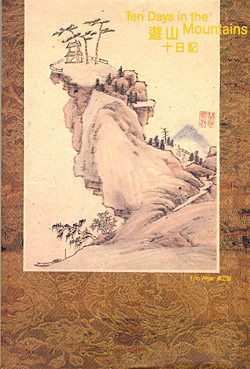Features
Ten days in the mountains 遊山十日記
 | |
Look inside the book | |
 | |
| Some random notes for my daughters - on enjoying paintings |
Eric Otto Wear, 2003
Besides being the result of a personal passion for Chinese art these past twenty years, this book represents another way of coming to art history. Inspired by the playful and elegant poetics of past Chinese literati life, I hoped to lightly recreate the experience of enjoying an album of painting for contemporary readers.
The starting point for this is a 10-page album of seemingly simple landscapes by the late Ming painter XIAO Yuncong (蕭雲從 1596-1673). This is reproduced as part of the book, with attention to preserving 1:1 scale, colour and the overall subtlety of the work (aspects that have been surprisingly neglected in most reproductions of Chinese art available in the market.) My bilingual text – of which only the English version is currently shown here - works as a counterpoint to the painting, leading towards ideas about time, experience, narrative and the act of painting. This was written with a view to pleasing both world-weary adults and the youngest of readers (indeed, it was first planned as a text to share with children – there being so very few books that make classical culture available to them).
The ideal readers are not specialists and probably not people who have previously given much thought to Chinese art. But they are people who expect their books to amuse and quicken their thoughts, and to be carefully written and beautifully produced.
The book was published by Hanart TZ Gallery with the support of the Hong Kong Arts Development Council. Hanart has been a major player in articulating the case for avant-garde Chinese art, but they also want to bridge the gap between the present and tradition. The book is distributed by MCCM Creations, a Hong Kong-based firm specialising in art and children’s books.
The book was profiled in Anne Odling-Smee's The New Handmade Graphics: Beyond digital design (Switzerland: RotoVision, 2002); and the Chinese portion was reproduced as a supplement - over ten days - on the literary pages of the China Times 中國時報, the largest circulation newspaper in Taiwan (March 2006).
Besides being the result of a personal passion for Chinese art these past twenty years, this book represents another way of coming to art history. Inspired by the playful and elegant poetics of past Chinese literati life, I hoped to lightly recreate the experience of enjoying an album of painting for contemporary readers.
The starting point for this is a 10-page album of seemingly simple landscapes by the late Ming painter XIAO Yuncong (蕭雲從 1596-1673). This is reproduced as part of the book, with attention to preserving 1:1 scale, colour and the overall subtlety of the work (aspects that have been surprisingly neglected in most reproductions of Chinese art available in the market.) My bilingual text – of which only the English version is currently shown here - works as a counterpoint to the painting, leading towards ideas about time, experience, narrative and the act of painting. This was written with a view to pleasing both world-weary adults and the youngest of readers (indeed, it was first planned as a text to share with children – there being so very few books that make classical culture available to them).
The ideal readers are not specialists and probably not people who have previously given much thought to Chinese art. But they are people who expect their books to amuse and quicken their thoughts, and to be carefully written and beautifully produced.
The book was published by Hanart TZ Gallery with the support of the Hong Kong Arts Development Council. Hanart has been a major player in articulating the case for avant-garde Chinese art, but they also want to bridge the gap between the present and tradition. The book is distributed by MCCM Creations, a Hong Kong-based firm specialising in art and children’s books.
The book was profiled in Anne Odling-Smee's The New Handmade Graphics: Beyond digital design (Switzerland: RotoVision, 2002); and the Chinese portion was reproduced as a supplement - over ten days - on the literary pages of the China Times 中國時報, the largest circulation newspaper in Taiwan (March 2006).